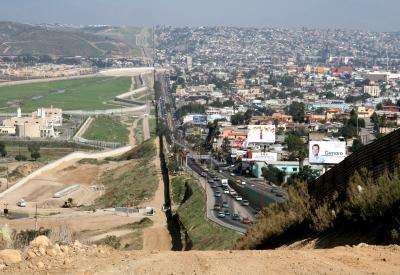All Souls Blog: Kidnapping in the US-Mexico Borderlands: Citizen Responses and the 'Intimacy-Distance Paradox
Conor O’Reilly is Professor in Transnational Crime and Security at the University of Leeds and Programme Director for the MSc in Security, Conflict and Justice. He is PI for the Newton Fund (Mexico) - Project M.A.K.E. (Mobile Solutions to the Mexican Kidnapping Epidemic: Beyond Elite Counter-Measures, Towards Citizen-Led Innovation). For this discussion he has focused on the issues surrounding kidnapping in Mexico; from both an academic lens and a citizen-led counter-kidnapping perspective.
Posted
Time to read
Drawing on his robust academic and research experience with Project M.A.K.E, Professor Conor O’Reilly addressed the under-researched but pervasive problem of Mexican kidnapping in the Borderlands. In particular, how can you counter kidnapping when you cannot access private solutions or rely on the state?
Making the case for why kidnapping is under-researched, Professor O’Reilly demonstrates that it is predominantly a Southern crime issue, with the vast majority of kidnappings occurring in Mexico, Colombia, Nigeria and conflict zones in the Middle East. Similarly, it is time to move beyond the narrative that it is predominantly elites who are kidnapped, with the illicit phenomenon now affecting those in the middle and lower socio-economic classes. It is a nuanced issue, requiring a high degree of contextualisation, with Professor O’Reilly noting that ‘whether it’s in a practical sense, a conceptual sense or a temporal sense, kidnapping has multiple levels and mutations.’ Motives for kidnapping can range from archetypal extortion, to intimidation of journalists, settling gang feuds or forced entry of the victim into trafficking or organised crime. There can be kidnapping of individuals, and kidnapping of space, insofar as cities are ‘held against their will’ by kidnapping and the urban architecture begins to change.

Before conceptualising his ‘intimacy-distance’ paradox, Professor O’Reilly reminds us that intimacy must be understood in its broader sociological sense. This means moving beyond immediate emotional proximity, that is, to incorporate ‘shared knowledge,’ ‘mutual action,’ ‘spatial relations’ and ‘the interactions that exist within families, within businesses, within communities.’
With kidnapping spreading to non-elite societal groups, how can it be countered without access to private solutions or state reliance? How can this be achieved in the Mexican state’s administrative context of high corruption, high levels of impunity and documented instances of police complicity in kidnapping?
Drawing from extensive qualitative fieldwork, Professor O’Reilly charted the themes of immobility and intimacy. Kidnapping is fundamentally about mobility and immobility, that is, the victim’s freedom of movement being curtailed. However, other mobilities and mobilisations ripple from this, particularly across the U.S-Mexico Border. Ransom requests flow across, transborder kidnappings occur, migrants can be kidnapped when attempting to enter the United States, there are those who live a cross-border life due to the threat of abduction, and a cross-border private security industry has surged. Significantly, these dynamics are bound up in the intimacy-distance paradox, whereby to preserve their connections with families, colleagues and businesses; people have to insert distance into various relations to preserve the intimacy that exists there.
This was demonstrable by how various communities and businesses changed in response to the growing threat of kidnapping in Mexican border towns such as Tijuana and Juarez. The medical tourism industry, where U.S. citizens travel to Mexican border towns for medical treatment, was one of the first sectors to be targeted for kidnapping. A wealthy, easily identifiable professional class of doctors and accessible walk-in surgeries led to 40 doctors being kidnapped in Tijuana in 2008. The result was that surgeries became anonymised and heavily securitised places. Similarly, the restaurant and maquiladora industries were also targeted, before kidnapping rippled beyond these elites to affect the middle classes.
How did people react to this? Means of citizen-led counter-kidnapping included; auto-contención (self-isolation), gated communities, closing social lives, removing visible displays of wealth and adopting everyday security protocol practice. According to O’Reilly, the result was “the erosion of the quality of life in the public space of these border settings.”
Underlying the intimacy-distance paradox is the ‘betrayal of intimacy.’ With reference to Ochoa’s ‘Treason Phenomenon,’ whereby some 70-80% of kidnapping situations arose from information given by someone known to the victim, Professor O’Reilly cites the ‘osmotic paranoia’ pervading Juarez and Tijuana. Even when kidnapping situations are resolved therefore, the victim has to deal with the knowledge that someone that they know has betrayed information that led to them being kidnapped. This is especially precarious when kidnapping can often happen again, to the same victim, in a subsequent attempt to further extort. The intimacy-distance paradox is evident through fatalist familial agreements to not pay ransoms if a single member is caught, in addition to families splitting across the border. With reference to the latter, which O’Reilly terms a ‘Transborder Secession,’ local Mexican border elites become elite refugees. In Juarez, for example, it is estimated that 11% of the population left the city, with the majority of those who could leaving for El Paso. Many of this population live in gilded gated communities, enjoying various private security measures and expedited cross-border access. Therefore, O’Reilly notes, a contrasting perspective emerges, whereby despite increasing discussion of the militarisation of the Border and the harm it does to migrants, for a certain class of Mexican elites, they were able to leverage the border to shield themselves from the threat of kidnapping.
This was not without a human toll however; chiefly the loss of intimacy and isolation from familial, community and business relationships. For example, and because many families would move the mother and children to the U.S. side of the border whilst the father stayed behind, there was a notably heavy toll on marriages. There was also the heavy weight of cultural separation and feeling of guilt from abandoning their hometowns. Ultimately, Professor O’Reilly argues, “the cost of security is the reduction of intimacy.”

Keywords:
Share
YOU MAY ALSO BE INTERESTED IN

